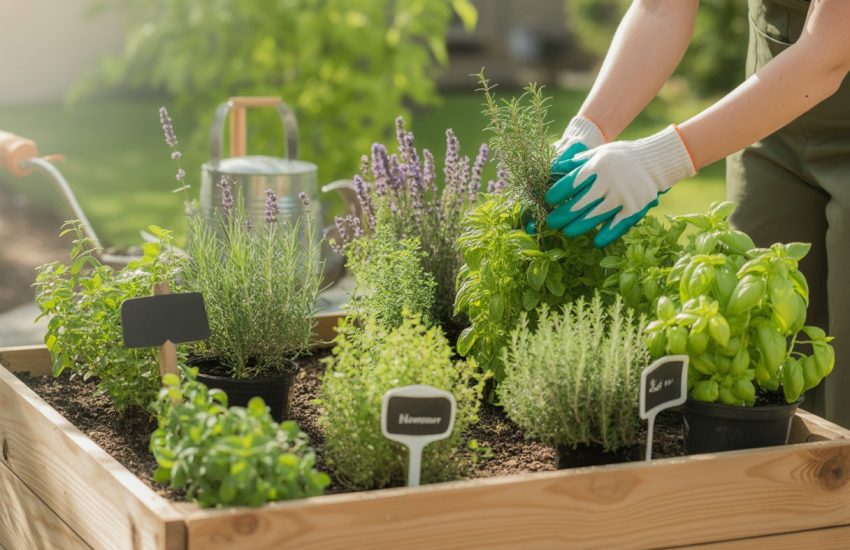How Far Apart to Plant Onions: A Clear Guide
Onions are a versatile vegetable that can be grown in a variety of ways. Whether you are a seasoned gardener or new to gardening, it’s important to know how far apart to plant onions to ensure a successful crop. This article will provide a guide on how to properly space your onions, whether you are planting sets or seeds.
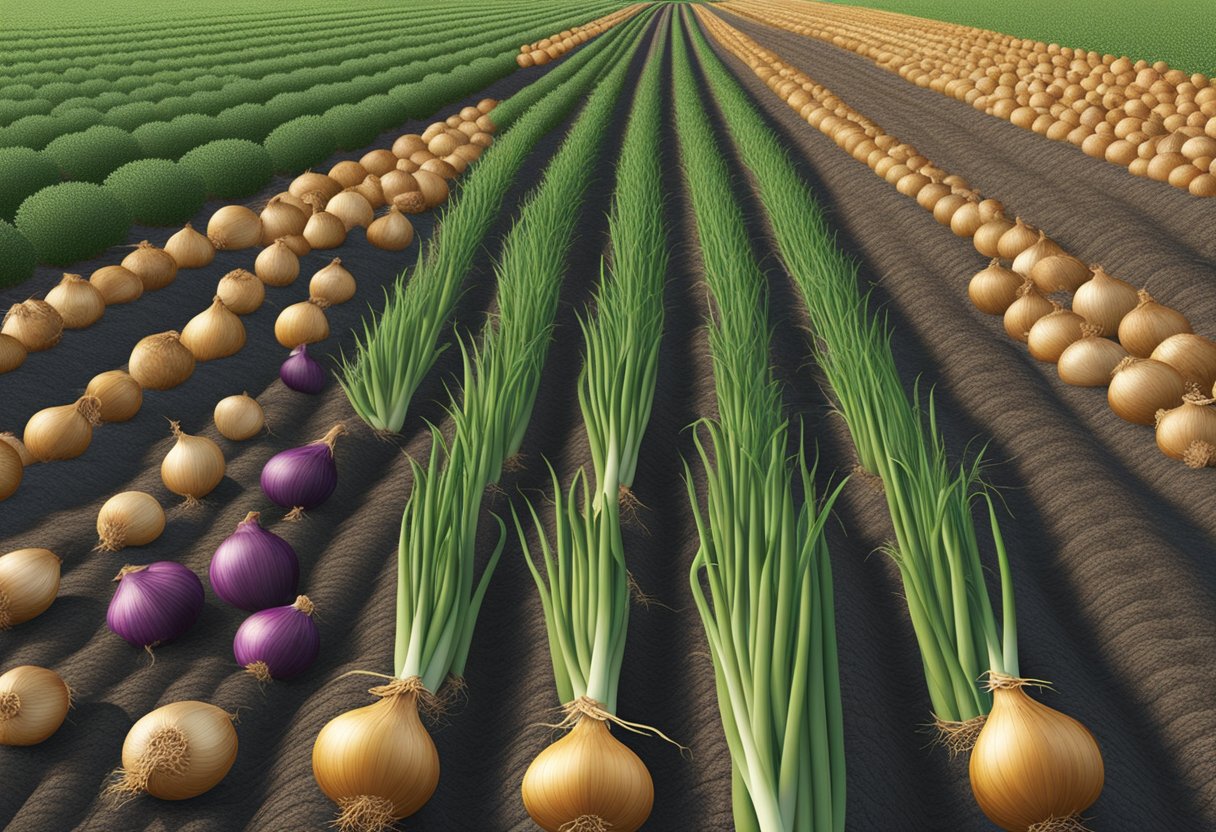
When it comes to planting onions, spacing is crucial. If you plant them too close together, they may not have enough room to grow and develop properly. On the other hand, if you space them too far apart, you may not be making the most efficient use of your garden space. The right spacing will depend on the type of onion you are planting, as well as the method of planting.
For those who prefer to plant onion sets, the spacing will be different than planting onion seeds. Onion sets are small bulbs that have been grown from seed the previous year. They are typically planted in the spring and should be spaced about 4-6 inches apart. Onion seeds, on the other hand, should be planted about 1 inch apart and thinned to 4-6 inches once they have sprouted. By following these guidelines, you can ensure that your onions have enough space to grow and thrive.
Understanding Onion Types
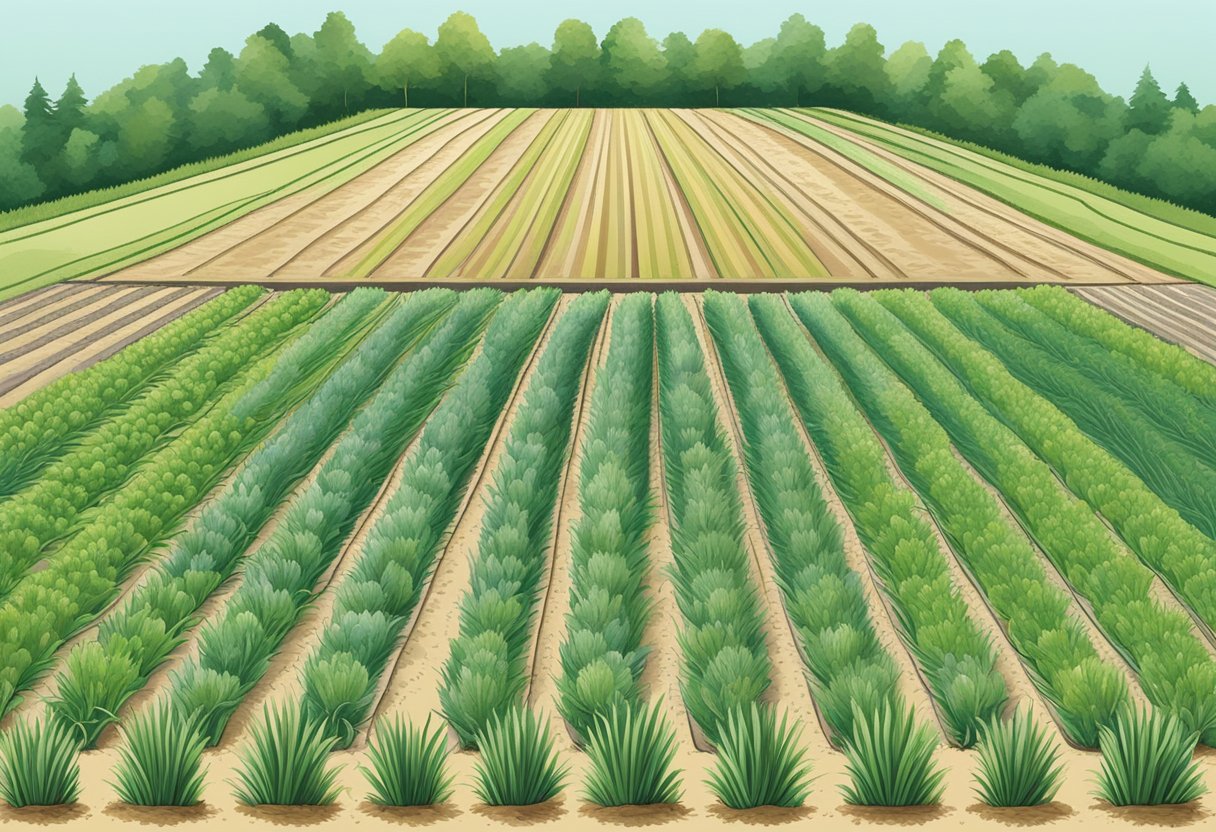
When it comes to planting onions, it is important to understand the different types of onions available. Onion varieties are classified according to the amount of daylight they need to form bulbs. The three main types of onions are short-day onions, long-day onions, and day-neutral onions.
Short-Day Onions
Short-day onions require 10-12 hours of daylight to form bulbs. They are best suited for planting in the southern regions where the daylight hours are shorter. Short-day onions are typically sweeter and have a milder flavor than other onion varieties. They are perfect for use in dishes where a mild onion flavor is desired.
Long-Day Onions
Long-day onions require 14-16 hours of daylight to form bulbs. They are best suited for planting in the northern regions where the daylight hours are longer. Long-day onions are typically stronger and have a more pungent flavor than other onion varieties. They are perfect for use in dishes where a strong onion flavor is desired.
Day-Neutral Onions
Day-neutral onions require 12-14 hours of daylight to form bulbs. They can be planted in both the northern and southern regions. Day-neutral onions are typically milder in flavor than long-day onions but stronger than short-day onions. They are perfect for use in a variety of dishes where a medium onion flavor is desired.
When choosing onion varieties, it is important to consider the region in which they will be planted and the desired flavor profile. By understanding the different types of onions available, gardeners can ensure a successful onion harvest.
Preparing the Planting Site
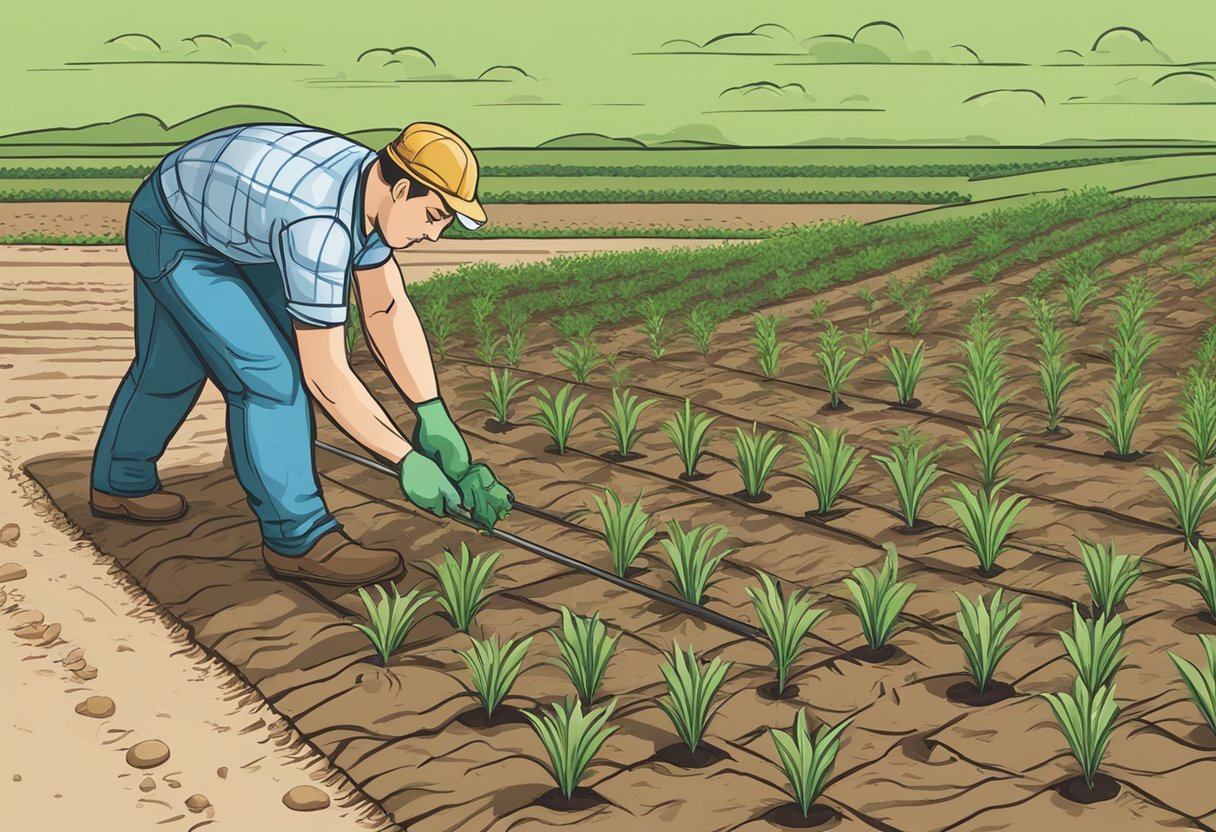
Soil Requirements
Before planting onions, it is important to ensure that the soil is well-draining and has a pH level between 6.0 and 7.5. Onions prefer a slightly acidic to neutral soil. To achieve this, you may need to add lime to raise the pH or sulfur to lower it.
Onions also require soil that is rich in organic matter. Adding compost to the soil can help increase the amount of organic matter and improve soil structure, which in turn promotes healthy root growth.
Site Selection
Onions require full sun to grow properly, so it is important to choose a site that receives at least 6 hours of direct sunlight per day. Additionally, the site should have good drainage to prevent waterlogging, which can lead to root rot.
Bed Preparation
To prepare the planting site, first remove any weeds or debris from the area. If the soil is compacted, it may be necessary to loosen it with a garden fork or tiller.
If the soil is heavy clay or poorly draining, consider planting onions in raised beds. This will ensure that the soil is well-draining and will also make it easier to control weeds and pests.
Once the soil is prepared, add a layer of compost or well-rotted manure to the surface and work it into the top few inches of soil. This will help provide the onions with the nutrients they need to grow and thrive.
Planting Onions
Onions are a staple in many dishes and can be easily grown in a home garden. Proper spacing is important to ensure healthy growth and a bountiful harvest. The spacing requirements for planting onions depend on whether you are using onion sets, onion seeds, or onion seedlings.
Planting Onion Sets
Onion sets are small bulbs that have already begun to grow. They are typically planted in the early spring, as soon as the soil can be worked. Onion sets should be planted 1-2 inches deep and 4-6 inches apart. It is important to ensure that the pointed end of the set is facing up. Once the onions begin to grow, they can be thinned to 2-4 inches apart.
Planting Onion Seeds
Onion seeds can be planted directly in the garden in the early spring or started indoors 8-10 weeks before the last frost. If planting directly in the garden, the seeds should be planted ½ inch deep and 1 inch apart. Once the seedlings begin to grow, they should be thinned to 4-6 inches apart. If starting seeds indoors, they should be transplanted into the garden once the seedlings are 4-6 inches tall and the soil has warmed up.
Planting Onion Seedlings
Onion seedlings are young plants that have been started from seeds and are ready to be transplanted into the garden. They should be planted in the early spring, as soon as the soil can be worked. The seedlings should be planted 1 inch deep and 4-6 inches apart. Once the onions begin to grow, they can be thinned to 2-4 inches apart.
Overall, onions should be planted in well-drained soil in a location that receives full sun. The soil should be amended with compost or other organic matter before planting. Onions should be watered regularly and kept free of weeds. With proper spacing and care, onions can be a rewarding addition to any home garden.
Optimal Spacing for Onions
When it comes to planting onions, it is important to consider the spacing between rows and individual plants. Proper spacing can help ensure healthy growth and maximum yield. Here are some recommendations for optimal spacing for onions.
Row Spacing
The spacing between rows largely depends on the size of the onion bulbs. For smaller bulbs, a row spacing of 12-18 inches is recommended. For larger bulbs, a spacing of 18-24 inches is ideal. This allows enough space for the bulbs to grow and for proper airflow between the rows.
Plant Spacing
The spacing between individual onion plants is also important. For larger bulbs, a spacing of 4-6 inches between plants is recommended. For smaller bulbs, a spacing of 2-4 inches between plants is ideal. This ensures that each plant has enough space to grow and develop without competing with neighboring plants.
It is important to note that spacing recommendations may vary depending on the specific variety of onion being grown. It is always best to consult the seed packet or a trusted gardening resource for specific recommendations.
Overall, proper spacing is crucial for healthy onion growth and maximum yield. By following these recommendations for row and plant spacing, gardeners can ensure a successful onion harvest.
Growing Onions
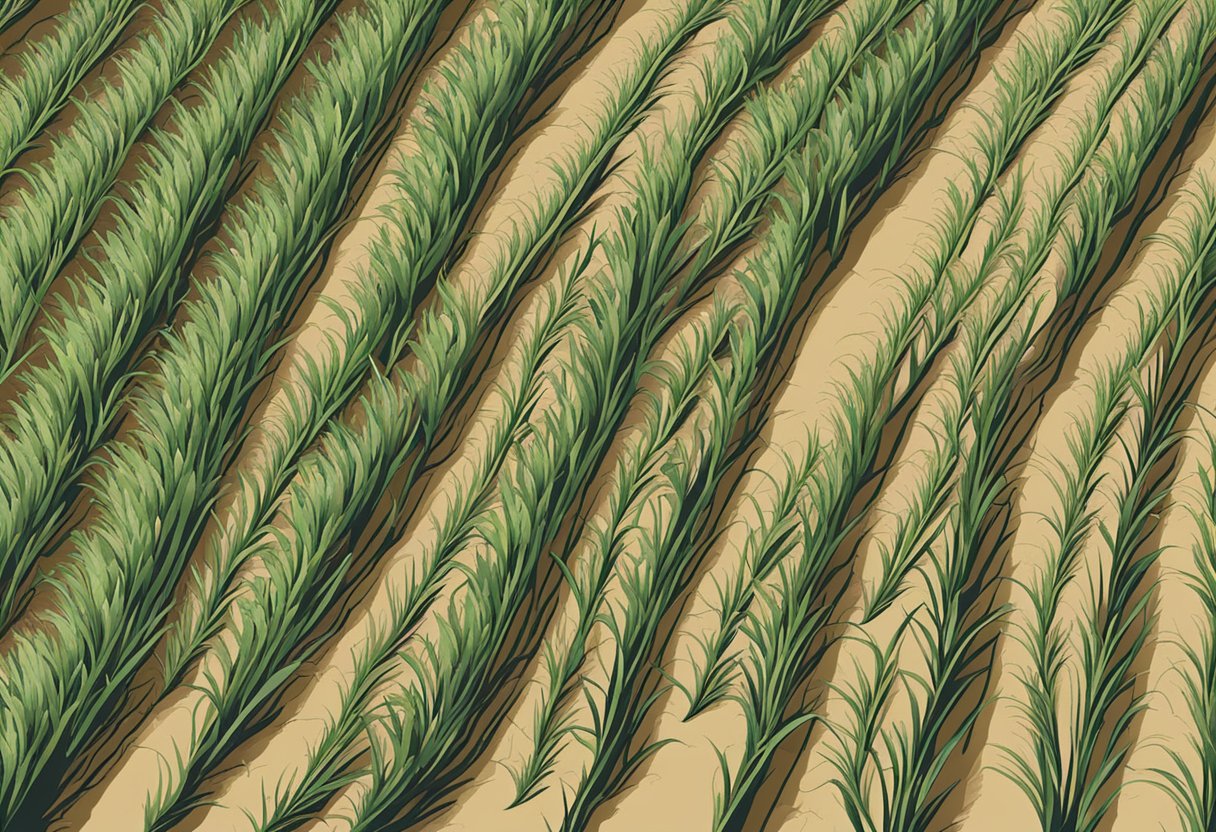
Onions are easy to grow and require little care. One important factor to consider when planting onions is the distance between them. Proper spacing ensures that each onion has enough room to grow and develop into a healthy bulb.
Watering and Nutrients
Onions require consistent watering, especially during dry spells. It’s important to water deeply and frequently, ensuring that the soil stays moist but not waterlogged. Onions also require nutrients to grow properly. A balanced fertilizer can be applied at planting time and again after the bulbs have started to form.
Weed and Pest Management
Weeding is important to keep the area around the onions clear of competition. Mulch can be used to help suppress weeds and retain moisture. Pest management is also important for growing healthy onions. One common pest is the onion fly, which lays its eggs at the base of the plant. Diatomaceous earth can be used to deter the onion fly and other pests.
Overall, onions require little care beyond proper spacing and consistent watering and nutrient application. With these factors in mind, anyone can grow delicious and healthy onions in their garden.
Container and Small Space Gardening
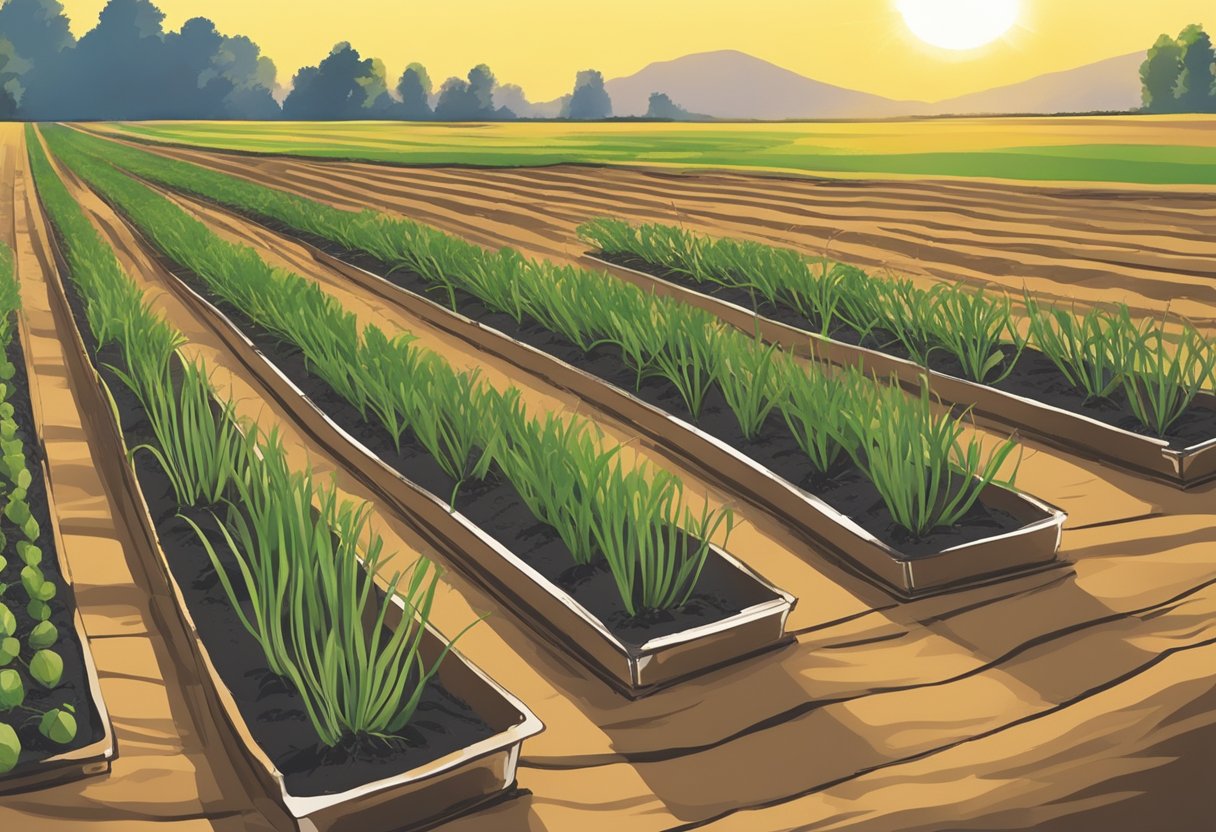
Choosing Containers
When it comes to container gardening, choosing the right container is crucial. The container should be large enough to accommodate the size of the onion bulb and allow for proper drainage. It is recommended to use a container that is at least 6 inches deep and 6 inches wide for each onion bulb.
In addition to the size, consider the material of the container. Plastic, ceramic, and metal containers are all suitable options for growing onions. However, it is important to note that metal containers can heat up quickly in the sun, which can damage the roots of the onion plant.
Container Spacing
When planting onions in containers, spacing is important to ensure proper growth and development. For small bulbs, plant them 2-3 inches apart in the container. If you are using a partitioned container, make sure to leave enough space between each partition to allow for proper growth.
For larger bulbs, plant them 4-6 inches apart in the container. It is important to avoid overcrowding the container to prevent competition for nutrients and water.
If you plan on using a permanent container for your onion plants, make sure to refresh the soil every year. This will help prevent soil-borne diseases and ensure optimal growth for your onion plants.
Overall, container gardening is a great option for those with limited space or who want to grow onions indoors. By choosing the right container and spacing your onion bulbs properly, you can enjoy a bountiful harvest of fresh onions.
Caring for Onion Plants

Light and Temperature
Onion plants require full sun exposure, which means they need at least six hours of direct sunlight per day. They should be planted in a location that receives full sun, which will help them grow strong and healthy. Additionally, onion plants prefer cooler temperatures between 55 and 75°F. If temperatures get too hot, onion plants may bolt, which means they will produce a flower stalk instead of a bulb.
Mulching and Support
To maintain moisture and suppress weeds, it is recommended to mulch onion plants with a layer of organic material such as straw or leaves. This will help keep the soil moist and cool, which is essential for healthy onion growth. Additionally, onion plants may require support if they become top-heavy. This can be achieved by placing stakes or cages around the plants to prevent them from falling over.
By following these simple tips, onion plants can thrive and produce a bountiful harvest.
Harvesting and Storing Onions

When to Harvest
Knowing when to harvest onions is crucial to ensure that they are fully matured and ready for storage. Mature onions are indicated by the growth of the bulb, which should be firm and fully formed. The leaves of the onion plant will also start to turn yellow and fall over. At this point, it is time to harvest the onions.
Curing and Storage
After harvesting, it is important to cure the onions before storing them. Curing involves drying the onions in a warm, dry location with good air circulation for 2-3 weeks. This allows the outer layers of the onion to dry and form a protective layer that will help prevent rotting during storage.
Once the onions are fully cured, they can be stored in a mesh bag or other container that allows for air circulation. Small bulbs should be used first as they will not store as well as mature onions. Mature onions can be stored for several months in a cool, dry location.
It is important to regularly check stored onions for any signs of rotting or softening. Any onions that show signs of decay should be removed immediately to prevent the spread of spoilage to other onions.
Common Challenges and Solutions

Diseases and Disorders
Onions are prone to several diseases and disorders that can affect their growth and yield. Some of the common diseases include onion rot, downy mildew, and onion smut. These diseases can be caused by fungi and bacteria that thrive in damp and humid conditions.
To prevent these diseases, it is important to keep the onion bed clean and dry. Avoid planting onions in areas where water tends to accumulate and use well-draining soil. Crop rotation is also important to prevent the buildup of pathogens in the soil.
If you notice any signs of disease, such as yellowing leaves or rotting bulbs, remove the affected plants immediately to prevent the spread of the disease. You can also treat the onion bed with fungicides to control the spread of disease.
Onion Pests
Onion pests can also cause significant damage to your crop. The most common pest is the onion fly, which lays its eggs on the base of the onion plant. The larvae then burrow into the bulb, causing it to rot and become unusable.
To prevent onion fly infestations, cover the onion bed with a fine mesh netting to prevent the adult flies from laying their eggs on the plants. You can also use diatomaceous earth, which is a natural insecticide that kills the larvae of the onion fly.
Other pests that can affect onions include thrips, aphids, and onion maggots. These pests can be controlled with insecticides or by introducing beneficial insects, such as ladybugs and lacewings, to the onion bed.
By taking steps to prevent diseases and pests, you can ensure a healthy and productive onion crop.
Advanced Tips and Techniques
Companion Planting
Onions can benefit from companion planting, which involves planting certain crops together to enhance growth and repel pests. Some good companion plants for onions include garlic, chamomile, and lettuce. Garlic and onions have similar requirements and can help each other repel pests. Chamomile can improve soil fertility and attract beneficial insects, while lettuce can act as a living mulch to keep the soil cool and moist.
Succession Planting
Succession planting involves planting crops at different times to ensure a continuous harvest. For onions, this means planting multiple batches throughout the growing season. This can be especially useful for gardeners who want to harvest onions at different stages of maturity. To do this, plant onions at different depths and intervals, starting with the largest bulbs and working down to the smallest.
When planting onions, it’s important to consider soil fertility and organic material. Onions thrive in well-draining, fertile soil that is rich in organic matter. To prepare the soil, add compost or aged manure before planting. This will help improve soil fertility and drainage, which can lead to healthier onion crops.
Overall, planting onions requires attention to detail and careful planning. With the right techniques and knowledge, gardeners can enjoy a bountiful harvest of delicious, homegrown onions.
Frequently Asked Questions
What is the optimal spacing for planting onion sets?
The optimal spacing for planting onion sets is typically 4-6 inches apart in rows that are 12-18 inches apart. This spacing allows the onions to grow and mature properly without competing for resources.
How deep should onion bulbs be planted?
Onion bulbs should be planted with the top of the bulb just below the soil surface. This depth ensures that the onion has enough room to grow and develop properly.
What is the recommended plant spacing for onions in a raised bed garden?
In a raised bed garden, the recommended plant spacing for onions is typically 4-6 inches apart in rows that are 12-18 inches apart. This spacing allows for proper growth and development of the onions.
Can you advise on the spacing required for red onions specifically?
The spacing required for red onions is the same as for other onion varieties. Red onions should be planted 4-6 inches apart in rows that are 12-18 inches apart.
How does one determine appropriate spacing for onions in a square foot gardening method?
In square foot gardening, onions should be planted one per square foot. This spacing allows for proper growth and development of the onion without competing for resources with other plants in the square.
Are there any companion plants that should be avoided when planting onions?
Onions are generally compatible with most plants, but they should be avoided from being planted near beans and peas. These plants can stunt the growth of onions.


